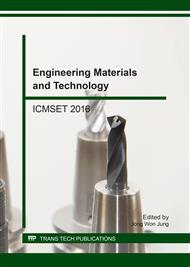[1]
S. Lordan, R. Paul Ross, C. Stanton, Marine Bioactives as Functional Food Ingredients: Potential to Reduce the Incidence of Chronic Diseases, Mar. Drugs. 9(6) (2011)1056-1100.
DOI: 10.3390/md9061056
Google Scholar
[2]
C. Dawczynski, R. Schubert, G. Jahreis, Amino acids, fatty acids, and dietary fibre in edible seaweed products, Food Chem. 103(3) (2007) 891-899.
DOI: 10.1016/j.foodchem.2006.09.041
Google Scholar
[3]
S. B. Lee, J. Y. Lee, D. G. Song, C. H. Pan, C. W. Nho, M. C. Kim, Cancer chemopreventive effects of Korean seaweed extracts, Food Sci. Biotechnol. 17(3) (2008) 613-622.
Google Scholar
[4]
S. K. Chandini, P. Ganesan, P. V. Suresh, N. Bhaskar, Seaweeds as a source of nutritionally beneficial compounds – A review, J. Food Sci. Technol. 45(1) (2008) 1-13.
Google Scholar
[5]
C. Peter, E. H. Micheal, Marine Biology, Eighth ed., McGraw-Hill Education, (2010).
Google Scholar
[6]
S. M. Arad, A. Yaron, Natural Pigments from Red Microalgae for Use in Foods and Cosmetics, Trends Food Sci. Technol. 3(4) (1992) 92-97.
DOI: 10.1016/0924-2244(92)90145-m
Google Scholar
[7]
R. Prasanna, A. Sood, A. Suresh, S. Nayak, B. D. Kaushik, Potentials and applications of algal pigments in biology and industry, Acta Botanica Hungarica, 49(1) (2007) 131-156.
DOI: 10.1556/abot.49.2007.1-2.14
Google Scholar
[8]
S. Paoline, J. C. Claire, D. Elie, I. Arsene, Commercial Applications of microalgae, J. Biosci. Bioeng. 101(2) (2006) 87-96.
Google Scholar
[9]
P. Indira, R. Biswajit, Commercial and industrial applications of micro algae – A Review, J. Algal Biomass Util. 3(4) (2012) 89-100.
Google Scholar
[10]
T. Nagai, T. Yukimoto, Preparation and functional properties of beverages made from sea algae, Food Chem. 81(3) (2003) 327-332.
DOI: 10.1016/s0308-8146(02)00426-0
Google Scholar
[11]
S. M. Burkinshaw, M. Mignanelli, P. E. Froehling, M. J. Bide, The use of dendrimers to modify the dyeing behaviour of reactive dyes on cotton, Dyes Pigm. 47(3) (2000) 259-267.
DOI: 10.1016/s0143-7208(00)00053-x
Google Scholar
[12]
A. K. M. Ismail, W. Y. W. Ahmad, M. R. Ahmad, M. I. Misnon, H. A. Jabbar, Fastness Properties and Colorimetric Characteristics of Low Temperature Dyeing of Natural Dyes from the Barks of Ixonanthes icosandra Jack on Polyester Fabric, 2013 IEEE Business Engineering and Industrial Applications Colloqium (BEIAC), (2013).
DOI: 10.1109/beiac.2013.6560168
Google Scholar
[13]
A. Z. Mercadante, Analysis of Carotenoids, in C. Socaciu (Eds), Food Colorants: Chemical and Functional Properties, CRC Press, New York, 2008, pp.447-478.
Google Scholar
[14]
U. M. L. Marquez, P. Sinnecker, Analysis of chlorophylls, in C. Socaciu (Eds), Food Colorants: Chemical and Functional Properties, CRC Press, New York, 2008, pp.429-446.
Google Scholar
[15]
M. Yusuf, M. Shahid, M. I. Khan, S. A. Khan, M. A. Khan, F. Mohammad, Dyeing Studies with Henna and Madder: A Research on Effect of Tin (II) Chloride Mordant, J. Saudi Chem. Soc. 19(1) (2011) 64-72.
DOI: 10.1016/j.jscs.2011.12.020
Google Scholar
[16]
M. M. Marie, G. M. Shokry, H. S. El-Khatib, M. F. Shahin, One Bath Cationization and Dyeing of Cotton Fabric with Brazilwood Natural Dye, Int. J. Innov. Appl. Stud. 11(4) (2015) 928-941.
Google Scholar
[17]
National Institute of Health, PubChem Open Chemistry Database, Retrieved on 4th April 2016 from https: /www. ncbi. nlm. nih. gov/pccompound.
Google Scholar


